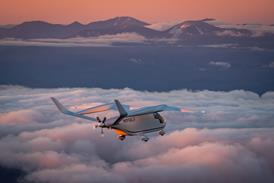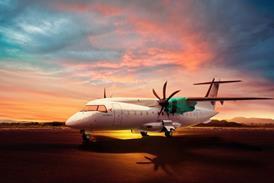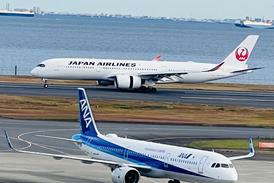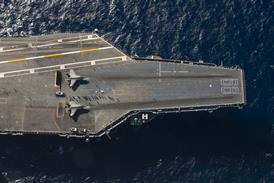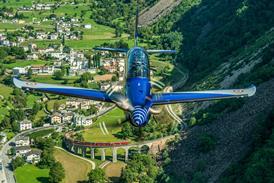The US DoD's 1997 budget request represents a 6% decline in defence spending.
Ramon Lopez/WASHINGTON DC
THE US Department of Defense (DoD) has sent to Capitol Hill a fiscal year 1997 budget request which represents a 6% decline in Pentagon spending from the previous year's level, postponing for 12 months an upturn in weapons procurement.
The budget would provide $243 billion in budget authority and $248 billion in outlays. The request is within $200 million of the spending plan put forward a year ago, but, because of lower inflation, it will yield $4 billion more in buying power for the fiscal year. (Between FY1998 and FY2001 the savings are estimated to total $13 billion.)
As a result of the $4 billion windfall, the Pentagon can afford an additional 180 Sikorsky UH-60 utility helicopters and will speed procurement of Javelin and Hellfire anti-tank missiles.
The budget request funds few new weapons programmes, but only two major projects - the US Army's Armoured Gun System (AGS) and the Hunter unmanned aerial vehicle - are terminated.
Pentagon spending for the current fiscal year, which began on 1 October 1995, was to have totaled $246 billion, but in 1995, US lawmakers added $6 billion in spending authority, giving the DoD a total of $252 billion. US President Bill Clinton did not follow through with a threatened veto, and the US Congress is likely to boost the FY1997 spending figure as well.
Of the $243 billion requested for next year, $39 billion would be for procurement, while research-and-development (R&D) spending would total $35 billion. The plan calls for Pentagon spending to rise to $248 billion in FY1998, $254 billion in FY1999, $262 billion in FY2000 and $270 billion the following year. R&D spending would hold steady, while weapons purchases would increase gradually.
US ARMY
Sikorsky will gain from the Pentagon's FY1997 spending plan because multi-year procurement of UH-60 Black Hawks ends in FY1996. Faced with a shut-down of production, the helicopter maker made an unsolicited offer in 1995, involving a further 180 UH-60s for the US Army, Air Force, Navy and Marine Corps over five years, at a production rate of 36 a year.
Key elements of the scheme were for the USMC to scrap plans to modernise 100 Bell Helicopter Textron UH-1Ns in favour of new UH-60s, and the US Army was to buy 90 additional UH-60s.
The inflation-rate windfall allows the US Army to buy 172 additional UH-60As and UH-60Ls. The budget request includes $356 million for an initial 36 UH-60s, including eight USAF HH-60G Pave Hawk search-and-rescue variants. USMC involvement is no longer needed, since the US Army will take 36 UH-60s each year between FY1998 and FY2001.
The savings from lower-than-expected inflation will also be used to cut three years out of the planned 11-year procurement of Texas Instruments/Lockheed Martin Javelin anti-tank missiles. It will pay for second-year procurement of the Longbow Hellfire and continued production of Laser Hellfire II missiles. R&D spending for the Boeing Sikorsky RAH-66 Comanche helicopter remains steady at about $290 million.
US NAVY
Naval aviation benefits with the first production funds for the McDonnell Douglas F-18E/F and the Bell Boeing V-22 tilt-rotor. Twelve Super Hornets, worth $2.6 billion, and four Ospreys, costing $1.2 billion, are budgeted for FY1997. The USN plans to buy 150 F-18s, worth $14 billion, between FY1998 and FY2001. In the same period it wants 31 V-22s, costing $4 billion.
Production of McDonnell Douglas T-45 trainers would hold steady at 12 units. Only ten McDonnell Douglas AV-8Bs would be remanufactured next year to offset the four additional aircraft funded in 1995 by US lawmakers. Two fewer Northrop Grumman E-2Cs would be funded, cutting the procurement request by more than half, to $141 million for the supply of two aircraft.
The USMC is proceeding with its $3 billion programme to upgrade 180 AH-1W helicopter gunships and 100 UH-1N utility helicopters. The USN will begin replacing Boeing Helicopter CH-46Ds used for vertical replenishment (Vertrep) missions beginning in FY1999. It will buy four, marinised UH-60s in that year, eight in FY2000 and nine in FY2001. Navy officials do not know whether all 72 Vertrep CH-46Ds will be replaced by UH-60s, leaving the door open for leasing commercial helicopters for some Vertrep operations.
US AIR FORCE
The Pentagon does not seek extra Northrop Grumman B-2 stealth bombers. The $500 million in funding added in 1995 will be used by the USAF to sustain its planned 20 B-2s. Eight McDonnell Douglas C-17 cargo aircraft, worth $2.3 billion, one Lockheed Martin C-130J, two E-8 Joint Stars aircraft, worth $786 million, four McDonnell Douglas F-15E strike aircraft, costing $339 million, and four Lockheed Martin F-16s, worth $253 million, are also requested. The USAF also seeks the first 12 Raytheon Beech MkII joint primary-training aircraft at a cost of $134 million.
Over $2 billion is requested for the Lockheed Martin/Boeing F-22 R&D and $582 million is sought for Joint Strike Fighter research.
Source: Flight International

